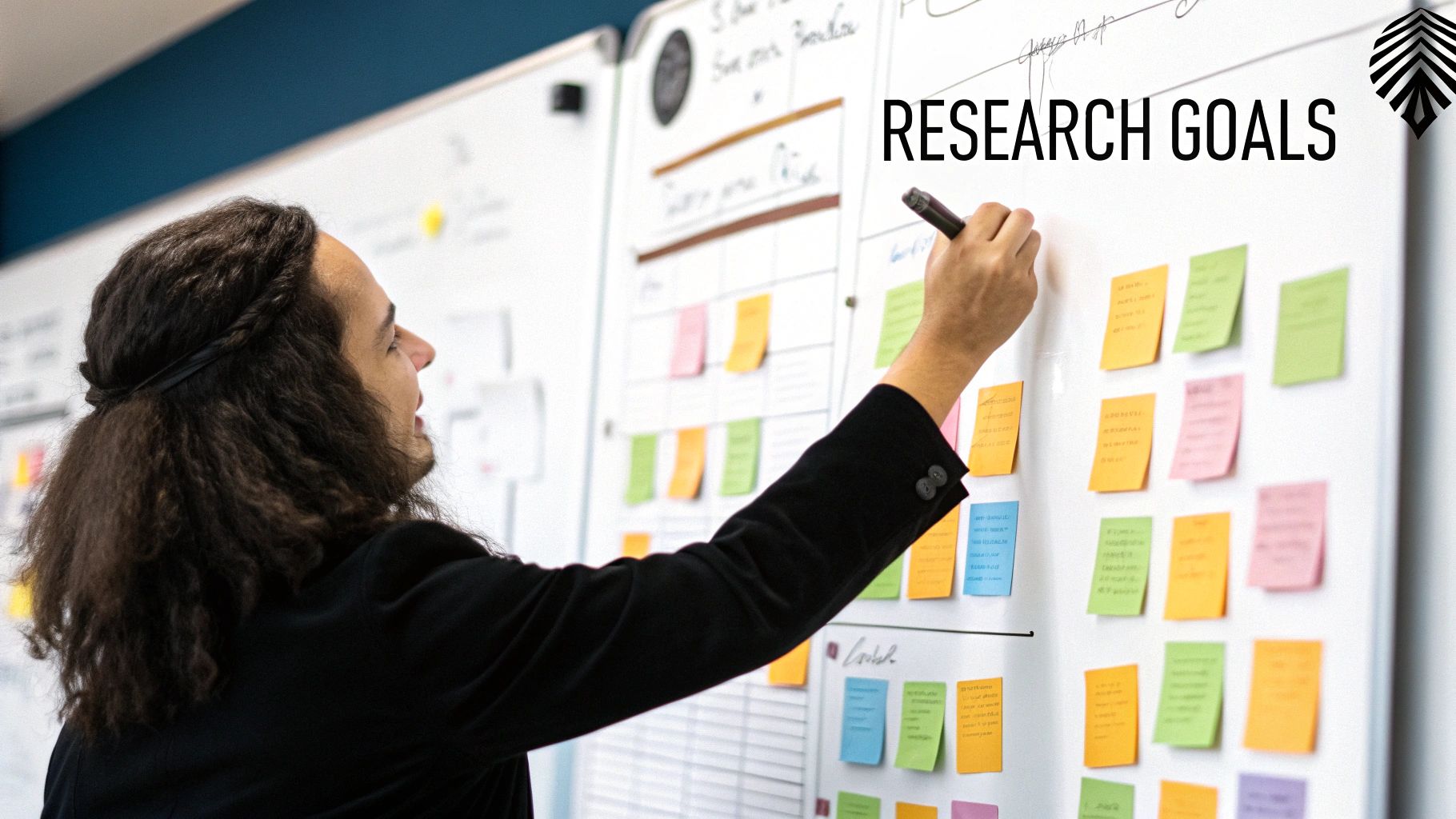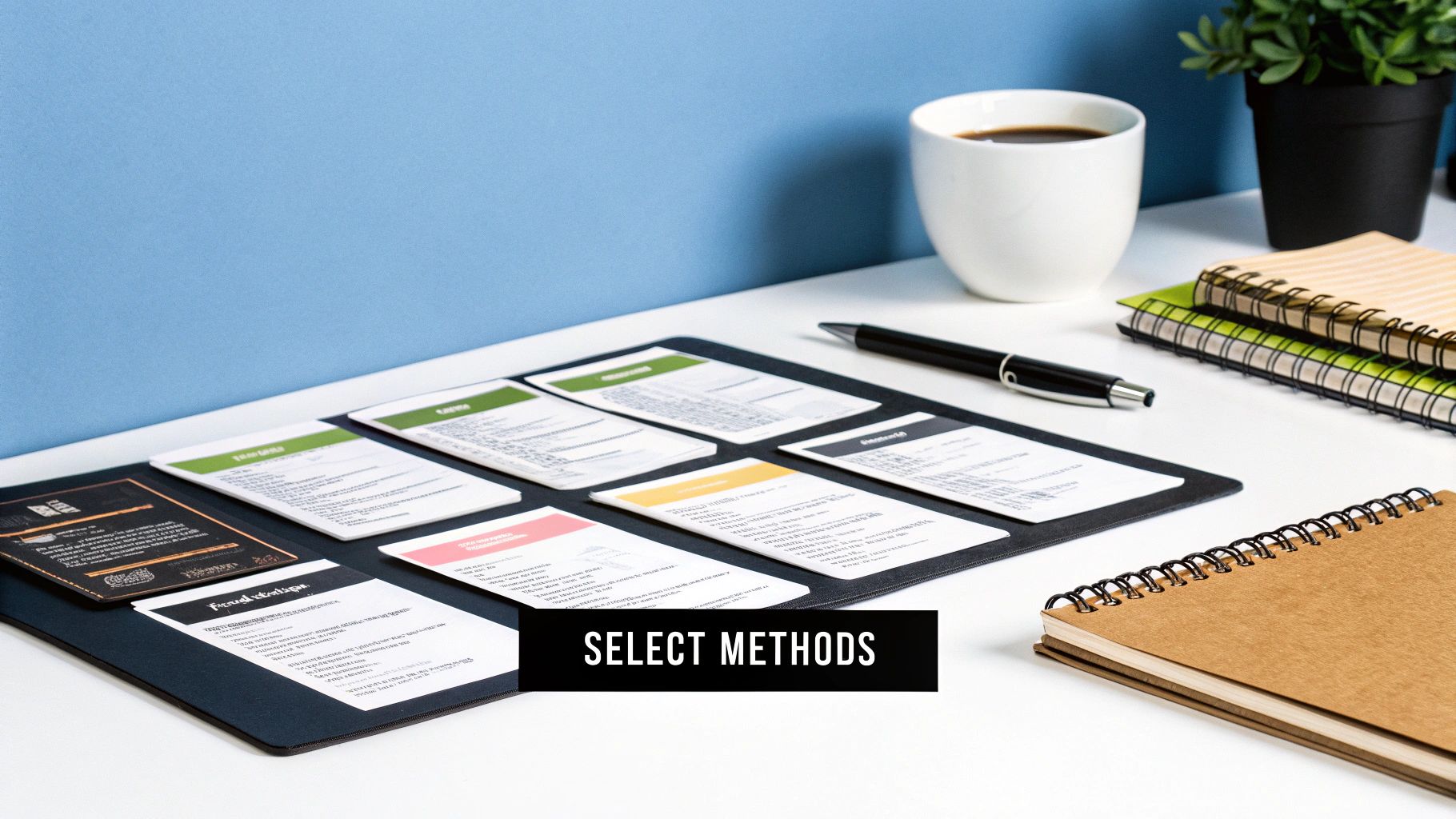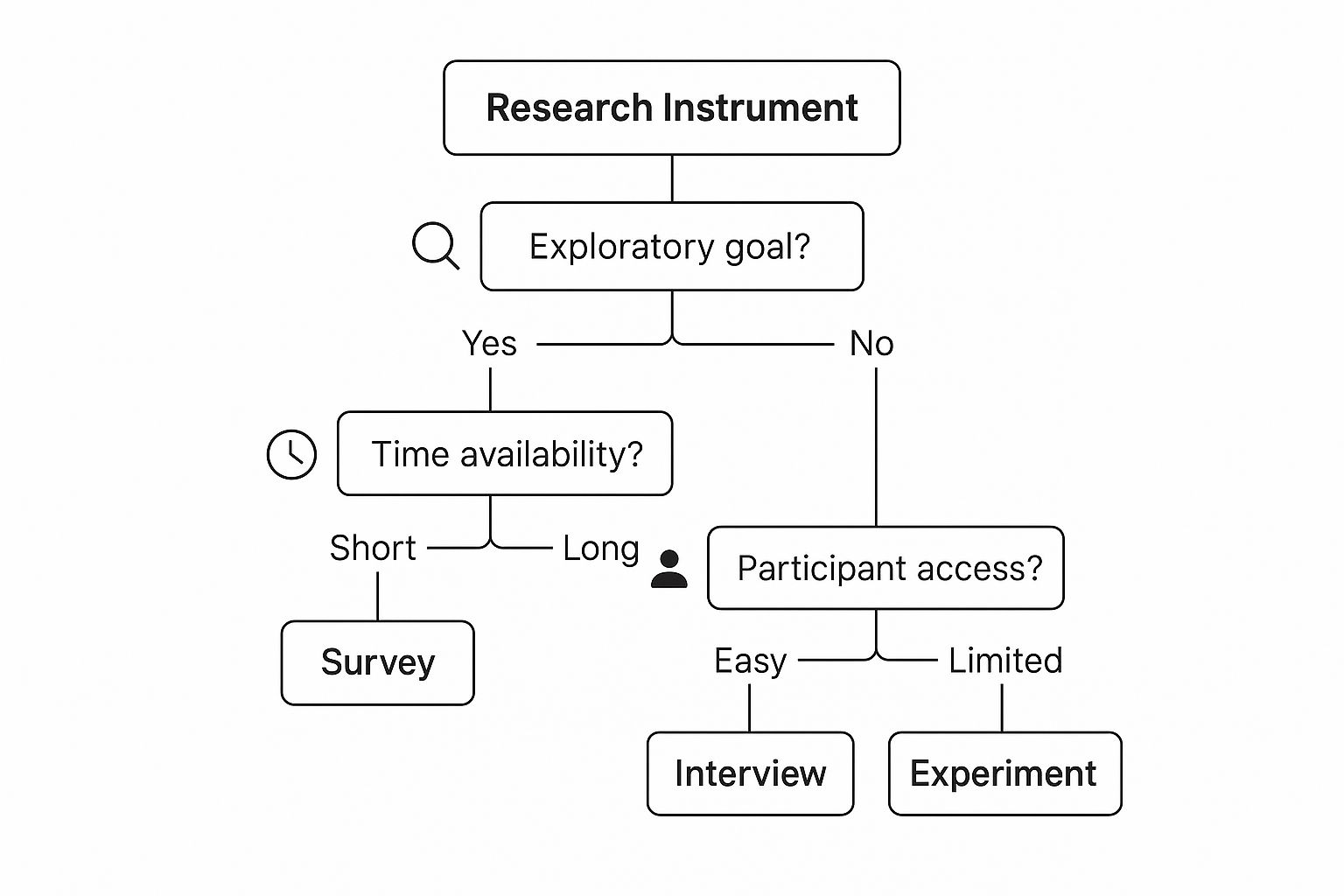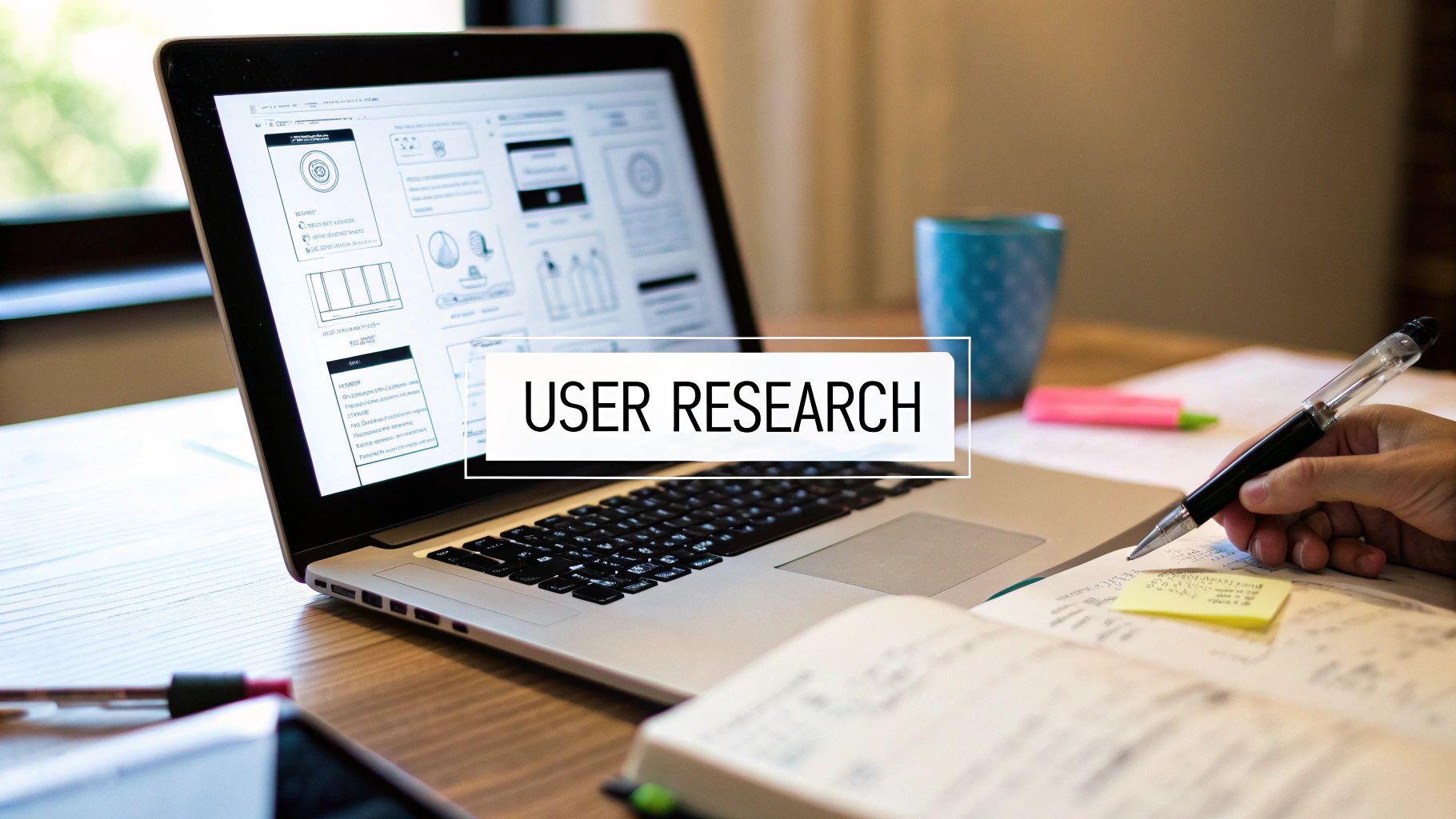If you want to conduct user research that actually works, you have to do more than just send out a survey. It's about setting clear goals from the start, picking the right research methods for the job, and then digging into the feedback to find those golden nuggets of insight. This is how you stop guessing and start building products people genuinely love and use.
Why User Research Is Your Secret Weapon

Before we jump into the "how," let's get grounded in the "why." User research isn't just a box to check on your project plan; it's the very foundation of a smart product strategy. It’s the only way to close the gap between what you think your users want and what they actually need.
We’ve all seen it happen. A team spends months building an elaborate new dashboard feature based on a hunch from a meeting. They launch it with high hopes, only to discover that less than 5% of users ever click on it. All that time, money, and development effort went into solving a problem nobody really had. That’s the high cost of skipping research.
The Real-World Impact of Listening to Users
Now, picture a different scenario. A company starts by talking to a handful of users. They quickly learn that customers don't want more data; they're just frustrated with one specific, tedious task. So, the team builds a simple feature to solve that single pain point. The result? Users adopt it almost overnight, and engagement goes through the roof.
That’s the power of user research in a nutshell. It swaps out risky assumptions for empathy backed by real evidence. And the benefits aren't just feel-good—they hit the bottom line.
Companies that consistently use research see incredible results:
- 83% improvement in product usability
- 63% higher customer satisfaction
- 34% increase in customer retention
These teams get results nearly 2.7 times better than competitors who neglect user insights.
User research is the most reliable way to avoid building something nobody wants. It’s an investment in confidence, giving your team the clarity to make smart decisions and build products with purpose.
This whole process is a key part of human-centered design. To see how these ideas fit into the bigger picture, you can explore our complete guide here: https://www.softriver.co/blog/your-guide-to-the-design-thinking-process-steps.
At the end of the day, it's about creating a continuous loop of feedback and improvement. For a deeper dive, I highly recommend understanding how user feedback improves products.
Building a Rock-Solid Research Plan

Powerful insights don't just appear out of thin air. They're the result of a deliberate, well-thought-out plan. Before you even think about talking to a single user, you need to lay the groundwork. This initial planning phase is what ensures every minute of your research is focused, relevant, and tied to actual business goals. It's how you move from just guessing to a structured, methodical investigation.
One of the biggest mistakes I see teams make is starting with vague, fuzzy goals. A question like, "Do people like our new app?" is too broad to be of any real use. It won't give you a clear direction or any data you can actually act on. A strong plan starts by getting rid of that ambiguity.
Let's reframe that objective. A much stronger goal would be something like, "Identify the top three friction points users encounter during our initial onboarding process." See the difference? This is specific, measurable, and directly linked to improving user experience and, ultimately, retention. Think of this well-defined goal as your north star for the entire project.
Formulating Sharp Research Questions
With your main goal locked in, it's time to break it down into smaller, more focused research questions. These are the specific things you absolutely need to learn from your users to hit your objective. They will become the backbone of your interview script, survey design, or usability test tasks.
Using our onboarding goal as an example, your research questions could look something like this:
- Where are people getting stuck or confused when they first set up their profile?
- What key piece of information are they looking for but can't seem to find?
- At what specific point do users feel frustrated enough to just give up and leave?
Notice how these questions are open-ended? They're designed to uncover behaviors and motivations, not just simple yes/no answers. This approach keeps you from asking leading questions and opens the door for those unexpected "aha!" moments to emerge. While user research zeros in on behavior, it's a great starting point for wider market analysis. We have another guide that dives deeper into how to conduct market research that drives growth.
Key Takeaway: A research plan's strength comes from its specificity. Every single question you ask should trace directly back to a clear business or product goal. This discipline is what separates aimless data collection from true, game-changing insight.
Identifying and Screening Your Participants
Even the most brilliant questions are useless if you're asking the wrong people. Figuring out your target audience is non-negotiable. Don't just grab anyone willing to talk; you need to define the key characteristics of the users whose feedback will actually be valuable.
Think about their demographics, their behaviors, and how familiar they are with your product or the problem you're solving. Are you looking for brand-new users who have never seen your app before, or are you trying to understand your seasoned power users? Maybe you need people who are loyal to a competitor's product.
The best way to do this is with a participant screener. This is just a short, simple survey designed to filter potential participants and make sure they're a good fit. For example, if you're researching a new feature for project managers, your screener should ask about their job title, the size of their team, and what project management tools they use every day. This extra step guarantees the quality of your data, making your final insights infinitely more reliable and impactful.
Choosing the Right Tool for the Job
Picking the right user research method is a lot like being a detective. You wouldn't dust for fingerprints if you're still trying to figure out if a crime even happened. The tool has to match the mystery you're trying to solve. Your choice will make or break the quality of the insights you get back.
There’s no magic, one-size-fits-all method. The best approach depends entirely on your research goals, how much time you have, and the specific questions you need to answer. Are you just starting to explore a new idea, or are you trying to fine-tune an existing design? Answering that first is half the battle.
Qualitative vs Quantitative Research
The first fork in the road is always qualitative versus quantitative. I like to think of it this way:
Qualitative research is all about the "Why?" It's where you dig deep into people's motivations, feelings, and frustrations. You get rich, detailed stories through methods like one-on-one interviews or just watching people in their natural habitat. The sample size is small, but the insights are deep.
Quantitative research answers "How many?" or "How much?" This is where surveys, analytics, and A/B tests come in. You're gathering structured, statistical data from a much larger group of users, which is fantastic for spotting patterns and confirming hunches at scale.
For example, a qualitative interview might reveal why a customer gets frustrated and gives up on your checkout process. Then, a quantitative survey could tell you that a whopping 65% of all users are abandoning their carts at that exact same spot. See how they work together? One gives you the story, the other gives you the scale.
Generative vs Evaluative Methods
Another crucial distinction is whether you're in discovery mode or testing mode.
Generative research (sometimes called exploratory) is all about uncovering new things. You do this early on, when you're still trying to wrap your head around user problems and hunt for new opportunities. Things like open-ended interviews or contextual inquiries are perfect for this because they often surface ideas you would have never thought of on your own.
Evaluative research, on the other hand, is for judging something that already exists. You use it to test a specific design or prototype to see if it actually works for people. The classic example is a usability test, where you sit someone down and watch them try to complete a task with your product.
A huge mistake I see teams make is using an evaluative method when they really need generative insights. Running a usability test on a half-baked concept won't tell you if you're solving the right problem—it'll only tell you if that specific solution is easy to use. Always start with discovery, then move on to evaluation.
This decision tree gives you a great visual for how to pick a method based on what you're trying to accomplish, your timeline, and how easily you can get in front of users.

As you can see, your real-world constraints—like only having two weeks or limited access to participants—are just as important as your research goals when it comes to picking a method that's actually practical.
To make this even easier, here’s a quick-reference table to help you match your goal to a solid research method.
Matching Research Methods to Your Goals
Think of this table as your starting point. The more you conduct research, the more you'll develop an intuition for which method will get you the answers you need most efficiently.
The Growing Software Ecosystem
The good news is, we have more tools at our disposal than ever before. The global User Research and User Testing Software Market was valued at around USD 35 billion in 2024 and is expected to rocket to about USD 113.8 billion by 2035.
This explosion is driven by a huge demand for platforms that can do it all—from usability testing and surveys to session recordings. It just goes to show how essential these practices have become. You can dig into the full research about the user testing software market if you want to see the numbers for yourself.
Choosing the right method is the critical step where a good plan turns into game-changing insights. If you take the time to match your tool to your task—thinking through qualitative vs. quantitative and generative vs. evaluative needs—you'll ensure your research is always on point and helps you build a better product. It’s a core skill in learning how to conduct user research the right way.
Running Research Sessions Like a Pro

This is where all your careful planning pays off. Running the actual research session is part science, part art. A great session should feel more like a guided conversation than an interrogation. That’s how you get the honest, unfiltered feedback you’re looking for.
Whether you're doing a one-on-one interview or putting together a survey, your main job is to make your participant feel comfortable enough to share their real thoughts.
For any moderated session, remember that your role is to guide, not to lead. The first five minutes set the tone for everything. Your first priority is to build rapport. Introduce yourself, briefly explain why you're talking today, and make it crystal clear that there are no right or wrong answers.
I always say something like, "Remember, we're testing the product, not you." This little phrase works wonders to lower their guard and invite genuine feedback.
The Art of the Open-Ended Question
As a moderator, the open-ended question is your best friend. It’s the difference between getting a one-word answer and a story.
Instead of asking, "Was that easy to find?" which just gets you a "yes" or "no," try something like, "Could you walk me through how you'd find that?" This simple switch invites them to narrate their entire thought process. You get to hear their expectations, their assumptions, and see exactly where they get stuck. The golden rule? Listen way more than you talk.
Good moderation is all about digging deeper without putting words in their mouth. Use neutral prompts to get them to elaborate:
- "Tell me more about that."
- "What were you expecting to happen when you clicked there?"
- "How did that make you feel?"
These kinds of questions keep the conversation going and help you uncover the why behind what a user is doing. Don't underestimate the power of silence, either. When a participant finishes a thought, just wait a few extra seconds. You’d be surprised how often they’ll fill the space with another nugget of valuable insight.
Mastering Unmoderated Methods and Ethics
When you’re not there to guide the conversation, like with a survey, your questions have to do all the heavy lifting. Clarity is everything. Steer clear of jargon, confusing double-barreled questions, and any language that might lead them to a specific answer.
A trick I always use is to pilot test my survey with a few colleagues first. They'll quickly spot any awkward phrasing before it goes out to hundreds of people.
No matter which method you're using, ethics are non-negotiable. This starts with getting informed consent from every single participant before you begin. You have to clearly explain what the research involves, how their data will be handled, and remind them they can stop at any time without any issue.
Essential Takeaway: Your job is to be an active, empathetic listener. Pay as much attention to what users do as to what they say. The most powerful insights often hide in a hesitant pause, a confused look, or a throwaway comment that hints at a much bigger frustration.
Focusing on both actions and words is what turns a simple feedback session into a goldmine. When you run your sessions with professionalism and care, you build trust and walk away with high-quality, reliable data.
From Raw Data to Game-Changing Insights
Collecting data is just the starting line. The real magic happens when you start digging into the analysis. This is where messy interview notes, hours of recordings, and raw survey numbers transform into clear, actionable insights that can genuinely change the direction of your product. Without a solid process here, even the best research data will just sit in a folder, completely unused.
First things first, you have to wrangle all your qualitative data into one place. This usually means transcribing interviews and pulling out the most impactful quotes from your session notes. Once everything is gathered, the real work of synthesis begins. If you're new to this, it helps to get familiar with different approaches. You can find a great breakdown on how to analyze user research data effectively to get your bearings.
Finding Patterns with Affinity Mapping
One of my favorite and most effective techniques for making sense of all that qualitative data is affinity mapping. Seriously, think of it as organizing chaos. You just write down individual observations, quotes, and behaviors onto separate sticky notes (digital or physical) and start grouping them.
Slowly but surely, themes will start to emerge. For example, you might notice a bunch of users all mentioning frustration with your app's notification settings. Boom, all those notes get clustered together. Another group might form around users who were surprisingly happy with the speed of your customer support. This process is so powerful because it visually reveals the biggest patterns and pain points without needing any complicated software.
The goal of analysis isn't just to report what users said. It's to understand the underlying need or motivation behind their words and actions. An insight connects an observation to a core human need.
This hands-on, collaborative approach is becoming the norm, and the tools we use reflect that. Today, cloud-based UX research platforms completely dominate the market, accounting for a massive 69.4% of the revenue in 2024. Their scalability and remote collaboration features are a lifesaver for teams that need to sift through findings together, no matter where they're located.
Crafting and Sharing Your Story
Once you've pulled out your key themes, you have to share them in a way that actually gets people to listen. Let's be honest, raw data is boring; stories are memorable. Instead of just walking into a meeting with a list of bullet points, build a narrative around what you found.
Here are a few things I always use to make my findings more compelling:
- Direct User Quotes: Powerful, verbatim quotes bring the user's voice directly into the room. It’s hard to argue with a real customer’s words.
- Short Video Clips: A two-minute clip of a user genuinely struggling with a feature is more impactful than a 20-page report could ever be.
- Simple Personas: Create some lightweight personas based on the behaviors and goals you observed. This helps the team empathize and remember who they’re actually building for.
Sharing these insights effectively is how you drive real action and show the value of your work. For a deeper look at tying research outcomes back to business impact, check out our guide on how to measure marketing effectiveness. By telling a compelling story backed by solid evidence, you ensure the user's voice is not just heard, but actually acted upon.
Common User Research Questions Answered
Even with a perfect plan in hand, you're bound to run into a few questions once you start doing the work. Let's tackle some of the most common ones I hear from teams just getting started with user research. Getting these sorted out early will save you a ton of headaches down the road.
One of the first things everyone wants to know is how many people they really need to talk to. It's a great question, but the answer isn’t some magic number.
How Many Users Do I Need for My Study?
For qualitative work like one-on-one interviews or usability tests, you can get a surprising amount of value from a pretty small group. You might have heard the old guideline that testing with just five users can uncover 85% of the major usability problems. It's a classic for a reason.
The real goal isn’t to hit a specific number, but to reach a point of saturation. That’s the moment you stop hearing new things. You know you’re there when the feedback starts getting repetitive and you aren't uncovering any more big, surprising issues. In my experience, this usually happens somewhere between 5 and 8 participants for each distinct user group you're studying.
But if you're running a quantitative study like a survey, the rules are completely different. You'll need a much bigger sample—we're talking hundreds or even thousands of people—to get statistically significant data you can confidently apply to your whole audience.
User Research vs. Market Research
I also see a lot of confusion between user research and market research. They sound similar and both are incredibly valuable, but they serve very different purposes.
Here's how I think about it:
- Market research is about what people say they want. It’s your eye on the bigger picture—market trends, what your competitors are up to, and general buying habits. It helps you find a promising business opportunity.
- User research is all about what people actually do. It gets you deep into their behaviors, their real needs, and what motivates them. This is how you make sure the product you build for that opportunity is actually useful and intuitive.
Think of it this way: Market research might tell you that 70% of people are looking for a new photo-sharing app. User research is what shows you exactly why they hate the current apps, revealing the specific frustrations you can solve.
How to Conduct Research on a Tight Budget
Worried you don't have the budget for this? Don't be. Some of the most powerful insights I've ever seen came from scrappy, low-cost research.
One of my favorite tactics is guerrilla research. This is as simple as it sounds: you go to a place where your target users hang out, like a coffee shop, and ask for five minutes of their time in exchange for a coffee. It's a fantastic way to get quick feedback on a prototype.
You can also use free tools like Google Forms for surveys or find participants by reaching out to your company's email list or social media followers. The most important thing is to get some direct feedback from real people. A little insight is always, always better than none at all.
At Softriver, we believe strong branding is built on understanding your audience. Our custom logo and brand identity packages are handcrafted by top design talent to ensure your business connects with the right people. Get a professional, market-aligned brand that drives results. Discover our branding solutions today.







